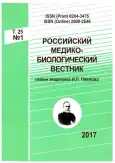THE MECHANISMS OF MOTOR AND VEGETATIVE MAINTANANCE OF MODELING ACTIVITY IN PATIENTS WITH EPILEPSY AND CLINICAL COURSE OF DISEASE
- Authors: Zorin RA.1, Lapkin MM.1, Zhadnov VA.1
-
Affiliations:
- Ryazan State Medical University named after academician I.P. Pavlov
- Issue: Vol 25, No 1 (2017)
- Pages: 76-85
- Section: Psychology, clinical psychology, neurology, psychiatry, narcology
- URL: https://journals.rcsi.science/pavlovj/article/view/6142
- DOI: https://doi.org/10.23888/PAVLOVJ2017176-85
- ID: 6142
Cite item
Full Text
Abstract
75 healthy people and 163 patients with epilepsy were observed. Using cluster analysis on the basis of characteristics of modeling activity we divided group of patients with epilepsy in 2 subgroups: resultative and low resultative. In low resultative subgroup of patients, the prevalence of symptomatic (structural-metabolic) forms of epilepsy, higher level of generalized seizures after correction of therapy, cognitive disorders and social desadaptation were determined. We studied the characteristics of motor systems (contingent negative variation, F-wave, simple and complex sensory-motor reactions) and vegetative maintenance of activity (parameters of heart rate variability, respiratory function). The insufficiency of activation of motor cortex, decrease of speed of simple and complex sensory-motor reactions, higher level of sympathetic influences in vegetative regulation and activity of respiratory effectors after modeling activity were established. Using artificial neural network technology, we classified the patients in subgroups with different resultness of acitivity. The most important in decision of this task were the characteristics of vegetative maintenance of activity. The excessive activation of stress realizing mechanisms in association with low resultness of activity increase the physiological cost of activity and decrease it’s efficiency.
Full Text
##article.viewOnOriginalSite##About the authors
R A. Zorin
Ryazan State Medical University named after academician I.P. Pavlov
Author for correspondence.
Email: zorin.ra30091980@mail.ru
Ph Russian Federation
M M. Lapkin
Ryazan State Medical University named after academician I.P. Pavlov
Email: lapkin_rm@mail.ru
Ph., M.D. Russian Federation
V A. Zhadnov
Ryazan State Medical University named after academician I.P. Pavlov
Email: Vladimir.zhadnov@mail.ru
Ph., M.D. Russian Federation
References
- Анохин П.К. Кибернетика функциональных систем: избранные труды. М.: Медицина, 1998. 397 с.
- Судаков К.В. Рефлекс и функциональная система. Новгород: НовГУ им. Ярослава Мудрого, 1997. 399 с.
- Карлов В.А. Эпилепсия у детей и взрослых, женщин и мужчин: руководство для врачей. М.: ОАО Издательство «Медицина», 2010. 720 с.
- Rektor I., Brazdil M., Nestrasil I., Bares M., Daniel P. Modifications of cognitive and motor tasks affect the occurrence of event-related potentials in the human cortex // The European Journal of Neuroscience. 2007. Vol. 26, №5. P. 1371-1380. doi: 10.1111/j.1460-9568.2007.05713.x.
- Меделяновский А.Н. Системные механизмы гомеостаза // Успехи физиологических наук. 1982. Т. 13, № 3. С. 96-126.
- Berg A.T., Berkovic S.F., Brodie M.J., Buchhalter J., Cross J.H., van Emde Boas W. et al. Revised terminology and concepts for organization of seizures and epilepsies: report of the ILAE Commission on Classification and Terminology, 2005-2009 // Epilepsia. 2010. Vol. 51, №4. P. 676-685. doi: 10.1111/j.1528-1167.2010.02522.x.
- Райгородский Д.Я. Практическая психодиагностика. Методики и тесты. Самара: Издательский Дом «Бахрах-М», 2001. 672 с.
- Гнездицкий В.В., Корепина О.С. Атлас по вызванным потенциалам мозга (практическое руководство, основанное на анализе конкретных клинических наблюдений). Иваново: ПресСто, 2011. 532 с.
- Мантрова Н.Н. Методическое руководство по психофизиологической и психологической диагностике. Иваново: ООО «Нейрософт», 2007. 216 с.
- Николаев С.Г. Атлас по электромиографии. Иваново: ПресСто, 2010. 462 с.
- Михайлов В.М. Вариабельность ритма сердца: опыт практического применения метода. Иваново: ИГМА, 2002. 290 с.
- Бяловский Ю.Ю., Абросимов В.Н. Капнография в общеврачебной практике. Saarbrucken: LAP LAMBERT academic publishing, 2014. 136 c.
- Боев В.М., Борщук Е.Л., Екимов А.К., Бегун Д.Н. Руководство по обеспечению решения медико-биологических задач с применением программы Statistica 10.0. Оренбург: Южный Урал, 2004. 208 с.
- Moein S. Medical diagnosis using artificial neural networks. Hershey: Medical Information Science Reference, 2014. 310 p.
- Калинин В.А., Якунина А.В., Повереннова И.Е. Закономерности течения эпилепсии в разные возрастные периоды // Неврология, нейропсихиатрия, психосоматика. 2015. S1. С. 26-30.
- Pulliainen V., Kuikka P., Jokelai-nen M. Motor and cognitive functions in newly diagnosed adult seizure patients before antiepileptic medication // Acta neurologica Scandinavica. 2000. Vol. 101, № 2. P. 73-78.
- Похачевский А.Л., Лапкин М.М. Состояние автономной (вегетативной) нервной системы и нарушения сердечного ритма при физической нагрузке // Российский медико-биологический вестник имени академика И.П. Павлова. 2013. Т. 21, №4. С. 49-56.
- Пшенникова М.Г. Стресс: регуляторные системы и устойчивость к стрессор-ным повреждениям. В кн.: Крыжановский Г.Н. (ред.) Дизрегуляционная патология. М.: Медицина, 2002. С. 307-324.
- Мокрова А.В. Применение метода искусственных нейронных сетей в оценке механизмов вертеброгенного болевого поясничного хронического болевого синдрома // Наука молодых (Eruditio Juvenium). 2015. № 3. C. 78-81.
Supplementary files







